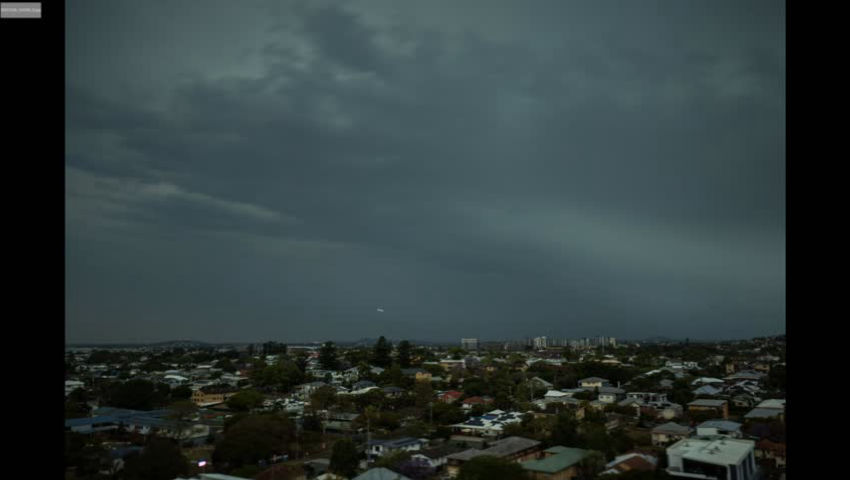This video is a slideshow of a series of photos I took with my drone as a storm approached Brisbane, with a strange phenomenon that I’m unfamiliar with.
You can see a horizontal bolt of lightning slowly crawling its way across the sky from left to right. What’s interesting is that each frame of the slide is an 8 second still, meaning that the bolt was visible in the sky for over a minute!
Apparently there’s something called “anvil crawler” lightning that can work its way across a cloud.
https://en.wikipedia.org/wiki/Lightning
https://en.wikipedia.org/wiki/List_of_lightning_phenomena
Anvil crawler lightning, sometimes called spider lightning, is created when leaders propagate through horizontally-extensive charge regions in mature thunderstorms, usually the stratiform regions of mesoscale convective systems. These discharges usually begin as IC discharges originating within the convective region; the negative leader end then propagates well into the aforementioned charge regions in the stratiform area. If the leader becomes too long, it may separate into multiple bidirectional leaders. When this happens, the positive end of the separated leader may strike the ground as a positive CG flash or crawl on the underside of the cloud, creating a spectacular display of lightning crawling across the sky. Ground flashes produced in this manner tend to transfer high amounts of charge, and this can trigger upward lightning flashes and upper-atmospheric lightning.[1]
But in the video I see of it, while it’s sustained by lightning standards, it all looks much shorter duration. This video is titled “Epic 3.72 second anvil crawler lightning”, so over a minute seems unlikely.
Are you sure that it’s not an aircraft, maybe illuminated in one way or another (e.g. a break in the clouds in the distance letting sun illuminate it directly, maybe?)
This would have been a very low flying aircraft, flying directly in to a very energetic thunderstorm! I have the 100MP original stills too, and there is no sign of an aircraft that I can make out

I had friends from Australia send videos of that storm in the last 24 hrs. I’m doubting any aircraft were in the air lol
What about a weather balloon?
considers
I still like the idea of an object, because it’d explain the slow and constant speed. I wonder if it’s possible for a conductive object, like aircraft, to induce strikes by being more-conductive than air. If it were flying along and there were a series of strikes on the aircraft. I can find footage of aircraft being hit by lightning in-flight, but not of one being hit repeatedly, though.
This is a post processed cropped version of one of the original stills. I have a hard time believing there’s an object behind it…

You know how lightning never strikes twice?
Well, that’s a myth. It loves to strike the same place twice. Hot air left behind after a strike is a conductor for the next one.
Lightning is just electricity moving. Electricity is one of those natural forces that wants equilibrium. When it’s far enough out of equilibrium, it has pressure or power of whatever you think of it as. It wants equal, a zero difference, a flat and dead environment. And a difference in that between regions creates something actionable. Nature can do something with that.
Lighting is basically a spark we can see with the charge being equalized. It’s a trade nature is making to level things out.
A minute long continuous discharge, slowly travelling across the sky is a little unusual though!
It only looks slow. There’s a lot going on there!
If the exposure time on each of those stills is long enough, that could easily be ball lightning moving enough to cause a streak on each frame.
Ball lightning is rare, but has been observed to wander around slowly, occasionally with an explosive end. This doesn’t go on long enough to see anything like that, though.
Either that or it’s something else bright and point-like doing the same thing, caught in the wind maybe.
The video is just a slide show of 8 photos, each photo with an 8 second exposure, so the actual motion was over 1 minute. I wasn’t aware of it when I was actually doing the captures though, so I caught it “mid strike”. The stills I took before and after those 8 frames were pointed at a different section of the sky, so I don’t know if it ended with a big discharge
While it’s possible that there are multiple phenomena behind things grouped up as ball lighting, there was a theory that it was basically the result of a lightning strike hitting the ground, vaporizing certain substances, and then the cloud of resulting gas rising and reacting momentarily while in the air.
A couple years back, there was some Chinese group studying lightning — not ball lightning — with some high-speed cameras and a spectrometer, and they got lucky and had one show up in their footage. The spectrogram showed that it was consistent with the “vaporized stuff from a strike on the ground” theory.
kagis
https://www.newscientist.com/article/dn24886-natural-ball-lightning-probed-for-the-first-time/
Natural ball lightning probed for the first time
The spectrograph revealed that the main elements in the ball were the same as those found in the soil: silicon, iron and calcium. The observations support a theory for making ball lightning put forth in 2000 by John Abrahamson at the University of Canterbury in New Zealand.
Abrahamson surmised that when lightning hits the ground, the sudden, intense heat can vaporise silicon oxide in the dirt, and a shockwave blows the gas up into the air. If there’s also carbon in the soil, perhaps from dead leaves or tree roots, it will steal oxygen from the silicon oxide, leaving a bundle of pure silicon vapour. But the planet’s oxygen-rich atmosphere rapidly re-oxidises the hot ball of gas, and this reaction makes the orb glow briefly.
The theory garnered support in 2006, when scientists at Tel Aviv University in Israel were able to create ball lightning in the lab by firing mock lightning at sheets of silicon oxide. The event in China marks the first time such an orb has been captured in nature with scientific instruments.
But I don’t think that what the footage shows is likely a cloud of gas reacting. It didn’t look like a bolt, and in the footage I saw, was just slowly rising. And it didn’t last very long, either.
Hard to say without more info, and I don’t know if there’s more specific terminology, but yeah this isn’t impossible. You need the right conditions, like enough electric potential in the right places, and the right conditions to make it “slow” (i.e. enough potential and a difficult-to-find path) but cloud-to-cloud and intra-cloud lightning is relatively common.
What sort of additional information?
Aliens.
Lightning can jump from cloud to cloud. But that’s a fucking alien.









